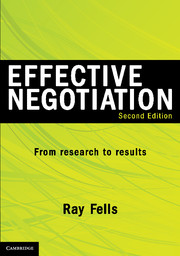Book contents
- Frontmatter
- Contents
- Preface
- Acknowledgements
- 1 Why isn't negotiation straightforward?
- 2 The DNA of negotiation
- 3 The knight's move
- 4 Phases and phrases
- 5 A negotiation script and other ways to manage a negotiation
- 6 Digging deep to deal with differences
- 7 Light bulb moments: exploring for options
- 8 A final balancing act: the end-game exchange
- 9 Building bridges
- 10 Cross-cultural negotiations: much the same but different
- 11 Becoming an effective negotiator
- References
- Index
5 - A negotiation script and other ways to manage a negotiation
- Frontmatter
- Contents
- Preface
- Acknowledgements
- 1 Why isn't negotiation straightforward?
- 2 The DNA of negotiation
- 3 The knight's move
- 4 Phases and phrases
- 5 A negotiation script and other ways to manage a negotiation
- 6 Digging deep to deal with differences
- 7 Light bulb moments: exploring for options
- 8 A final balancing act: the end-game exchange
- 9 Building bridges
- 10 Cross-cultural negotiations: much the same but different
- 11 Becoming an effective negotiator
- References
- Index
Summary
This chapter considers some ways to make a negotiation work better, which include
developing a negotiation script to help manage a negotiation
negotiation as a journey: the Nullarbor Model of negotiation
some advice about managing a negotiation, including when they deadlock
a description of the mediation process – how a third party can help
some practical implications for negotiators.
The previous chapter was quite complex, which should not be surprising because negotiation itself is complex. This complexity means that negotiators need something a bit more straightforward to work with when trying to manage their way through a negotiation.
One of the ways used to present the research insights was to talk about negotiation in terms of a river, one that has a broad flow and direction but whose volume and speed from headwaters to estuary are not constant. In the early stages the water might be running quite fast over rocks and waterfalls; later it slows and meanders, and all the while it eddies and forms other currents under the surface. Picturing a negotiation in this way helps a negotiator manage strategies and tactics at any point in the negotiation in the context of the broad flow of progress to an agreement. Negotiation as a river is one image or script. All negotiators intuitively work to a script of some sort, the most common being a competitive one that reflects their understanding of the pay-off structure and tactics of negotiation.
- Type
- Chapter
- Information
- Effective NegotiationFrom Research to Results, pp. 84 - 114Publisher: Cambridge University PressPrint publication year: 2012



